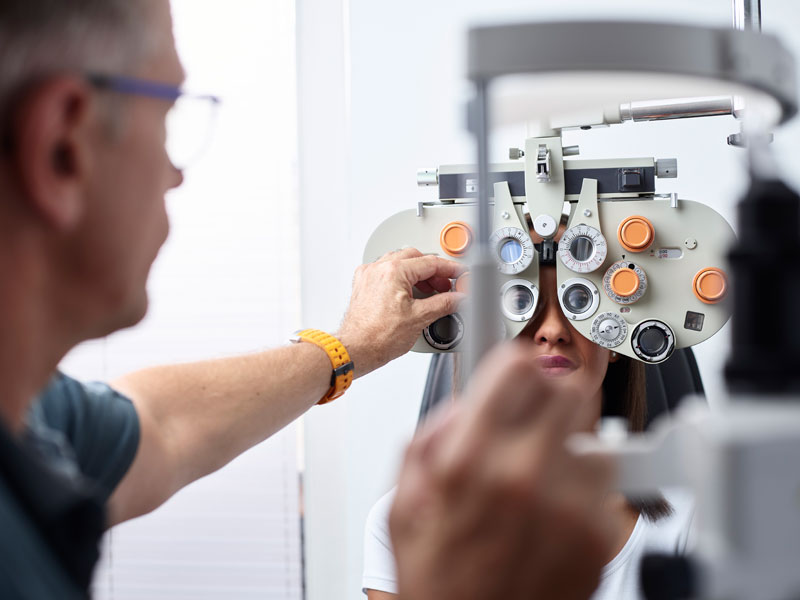Just How an Eye Doctor Can Help Prevent Vision Issues in Chino
Just How an Eye Doctor Can Help Prevent Vision Issues in Chino
Blog Article
Checking Out the most recent Technological Developments in Optometry and What They Mean for Optometrists
From the precision of Optical Comprehensibility Tomography to the nuanced understandings offered by AI-driven diagnostic devices, these innovations are setting brand-new criteria in individual evaluation and therapy. As these advancements permeate the practice, eye doctors are faced with the obstacle of accepting these devices to enhance client end results.
Advancements in Diagnostic Tools
Progressing the field of optometry, advancements in analysis tools have actually reinvented the method eye treatment professionals examine and identify ocular problems and visual impairments. The previous decade has actually observed considerable technological developments, making it possible for even more exact and detailed analyses.
Another key advancement is the introduction of innovative corneal topography systems, which map the surface area curvature of the cornea with precision. These devices are particularly advantageous for suitable contact lenses and identifying corneal problems. Furthermore, electronic retinal imaging has actually transformed conventional ophthalmoscopy, offering in-depth, breathtaking sights of the retina that promote detailed visual assessments.
The advancement of wavefront aberrometry has additionally been critical, making it possible for the evaluation of refractive mistakes with unparalleled accuracy (Eye Doctor Optometrist). This technology assists in tailoring rehabilitative lenses and enhancing medical end results for refractive surgical procedures. Jointly, these analysis improvements equip optometrists to deliver exceptional patient care, making sure early treatment and customized treatment strategies, ultimately enhancing visual health and wellness results
AI in Patient Monitoring
Structure on the foundation of advanced analysis devices, the incorporation of fabricated knowledge (AI) in person management represents a transformative jump for optometry. AI systems are significantly employed to boost performance, accuracy, and personalization in individual treatment. By assessing huge quantities of information, AI can determine patterns and predict possible eye conditions, allowing eye doctors to tailor treatments better. This ability is essential in handling chronic eye illness such as glaucoma and diabetic retinopathy, where very early discovery and continuous monitoring are crucial.
Additionally, AI-driven platforms help with streamlined client communications and administrative processes. Automated scheduling, virtual examinations, and customized follow-up plans not only improve person contentment however additionally optimize time management for professionals. These systems can triage individuals based upon the urgency of their conditions, ensuring that those in critical demand obtain punctual focus.
Furthermore, AI improves decision-making by giving optometrists with evidence-based referrals and treatment paths. By incorporating data from electronic health and wellness documents, AI devices use insights that educate scientific choices, reducing the risk of mistakes and improving patient outcomes. As AI remains to evolve, its role in client monitoring will likely broaden, reshaping the landscape of optometric care.
Advancements in Retinal Imaging
In the world of optometry, retinal imaging has actually experienced impressive technical advancements that are enhancing diagnostic abilities and person treatment. Technologies such as Optical Comprehensibility Tomography (OCT) and fundus digital photography have changed exactly how optometrists assess the retina and visualize.
Boosted imaging techniques like OCT angiography are more refining diagnostic accuracy. This non-invasive technique maps blood flow in the retina, providing important understandings into vascular health and wellness without the need for color shots. Furthermore, adaptive optics technology is being incorporated right into retinal imaging systems to deal with ocular aberrations, delivering extraordinary photo clearness. Such improvements facilitate the recognition of minute retinal modifications that might symbolize condition development.
Moreover, innovations in artificial intelligence are enhancing retinal imaging by making it possible for automatic analysis of large datasets. These systems help eye doctors in identifying patterns indicative of pathology, therefore enhancing diagnostic More Info accuracy and effectiveness. Jointly, these technologies are transforming retinal imaging into a foundation of contemporary eye treatment, boosting results and expanding restorative opportunities.
Teleoptometry's Growing Duty
Teleoptometry is significantly becoming a crucial element of eye treatment, driven by innovations in digital interaction and diagnostic tools. This is specifically helpful in underserved and rural locations where accessibility to specialized eye treatment is often minimal.
The combination of synthetic knowledge (AI) additional enhances teleoptometry, making it possible for the evaluation of aesthetic information and helping in the discovery of eye conditions such as glaucoma and diabetic retinopathy. AI-powered algorithms can rapidly interpret complicated imaging information, giving optometrists with useful insights that boost scientific decision-making.
Additionally, teleoptometry sustains continuity of care through seamless integration with electronic health documents (EHRs), enabling optometrists to maintain detailed patient histories. This guarantees that individuals get personalized and consistent care also when consulting with various practitioners.
Despite these benefits, difficulties continue to be, consisting of making certain information safety and security and managing individual expectations. Teleoptometry stands for a substantial stride in the direction of even more accessible, effective, and patient-centered eye treatment. As technology develops, its duty is poised to expand additionally.

Future Patterns in Eye Care
A myriad of ingenious patterns is readied to improve the future of eye care, driven by technical improvements and the advancing needs of individuals. One significant pattern is the combination of fabricated intelligence (AI) in diagnostics, which assures to enhance the precision and effectiveness of eye assessments. AI formulas can analyze substantial amounts of information from retinal images, potentially identifying conditions like diabetic person retinopathy and glaucoma earlier than traditional methods.
Moreover, personalized medicine is obtaining grip in optometry, with hereditary screening notifying tailored therapy strategies. This approach aims to maximize individual end results by tailoring interventions to private hereditary accounts. Wearable technology, such as smart call lenses, is likewise on the horizon, supplying real-time surveillance of intraocular pressure or glucose degrees, therefore offering continuous insights right into eye and systemic health.
The adoption of increased reality (AR) and online truth (VIRTUAL REALITY) in training and person education and learning is another arising pattern. These modern technologies offer immersive experiences that can enhance understanding and skills both for patients and optometrists. As these trends evolve, eye doctors More Bonuses should remain abreast of technological developments to supply advanced treatment, making sure enhanced person outcomes and you could try here fulfillment in the dynamic landscape of eye care.
Verdict

Collectively, these diagnostic innovations empower eye doctors to deliver remarkable patient care, making sure very early intervention and tailored treatment methods, ultimately boosting visual wellness outcomes.

As these modern technologies proceed to evolve, optometrists need to adjust and incorporate them into practice, ultimately enhancing process effectiveness and elevating the criterion of eye care supplied to patients.
Report this page